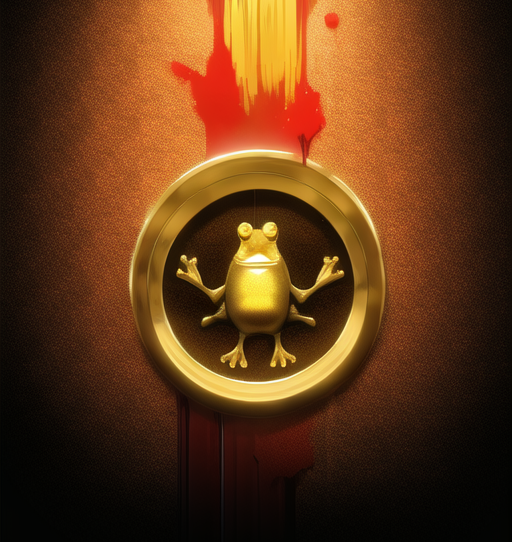Production Diary
How to make Game world Week 1
Game Design vs Level Design Function
In Wednesday's lesson, we were asked to pick 5 games that we had played previously and discuss their external, internal and rules of play. The image
on the right shows examples of games chosen by my classmates and their takes on it. Shown below are the games I had chosen.
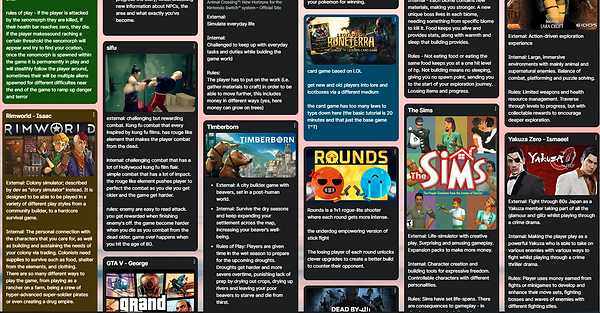
My 5 Game list
Assassin's Creed: Brotherhood

External: it is an open-world action game where the player, as Master Assassin Ezio, has to traverse the area through parkour, completing tasks.
Internal: Within 1500 Rome, Enzo attempts to overthrow the corrupt tyrants of the city. Being provided with a target which you have to stealthy assassinate, using the surroundings to hide.
Rules of play: Accidentally killing an NPC results in the player's cover being ruined, making them more easily spotted and susceptible to being chased.
Pokemon Sword

External: An open-world game filled with pokemon you must catch (including a legendary pokemon at the game's end).
Internal: Create a team to beat gym leaders and be the best pokemon trainer, utilising the pokemon you catch on your journies, levelling them up, and upgrading their abilities.
Rules of play: Different types are stronger than others (such as Fire Type moves will be more effective on Grass Type pokemon). Pokemon will faint once they reach 0 HP, and players will lost battle if their entire team (of 6) faints. However, they will gain experience if they do beat the enemy trainer/pokemon. Each pokemon has a certain amount of experience points that allow to level up and sometimes evolve into different pokemon, becoming stronger and able to learn better moves.
Yugioh Master Duel

External: Replicated the famous anime card game where players with a deck of cards, have to combine them in order to beat the enemy player and win the duel.
Internal: Customise a deck suited to your playing style, winning duels in order to finish storylines and advance your duelling skills, reaching a point where you can compete with friends and strangers.
Rules of play: Each player starts off with 8000 life points and 5 cards in their hand (drawing one each go), within a time limit players need to try to damage the enemy player until they reach 0 and win. Decks have limits within only a certain amount allowed as well as some cards not being allowed, furthermore, only some cards can be placed in one go. Cards on field have to be destroyed before player can be attacked.
Arknights

External: Anime role-playing game where you have to strategise in order to defend your tower and stop enemies from penetrating their base.
Internal: To stop the enemies from penetrating the player's base on a different map, players must place operators on the appropriate tiles.
Utilising a range of characters of different classes, placing them on specific tiles top block and damage enemies or heal and support other operators. Utilising a combination of classes to protect a player's base on a range of maps.
Rules of play: Can only play if you have enough sanity (A stamina-like feature), which increases with level, and you can not progress if this runs out.
Gundam Evolution

External: First-Person-Shooter where within a team 6 you compete in a range of modes, playing as the wide variety of mobile suits from the anime Gundam series, that best suits them in order to defeat an enemy team.
Internal: In different game modes players of 6 are split into 'Attackers' and 'Defenders' in: Point Capture, Domination, Destruction. Using your mobile suit individual skills to complete your main objective which may be: to take control of the 'Objective', fight to take control of 3 mission objectives by filling a suppression meter or destroy the 'objective' (with this being flipped on the defender's side).
Rules of play: Two players on the same team cannot play the same Mobile Suit character once the game has started; thus, you must select a character that hasn't already been chosen by another player. Also, take part in time-limited conflicts.
How to make Game world Week 2
Good and bad games that teach you how to play the game
Good Games
You can understand the basics of Gundam Evolution, such as how to move by utilising their abilities and fire at targets, with ease. The creators use a pop message to make things simple for gamers.

In the Naruto Shippuden: Ultimate Ninja Storm 4 game, the designers have created a guide with symbols and placed it on the screen to be visible to make it easy for players to understand how to be navigated and function in the game.

Bad Games
Gamers of The Legend of Zelda: Twilight Princess are discouraged from seeking out adventures. The game's plot develops far too slowly. It wastes the player's time with tutorial objectives like gathering fish so that a cat would go to the store with them. The intention is to show Link's easy life as a farmer before starting his quest, yet some players only care about having a play.

When you explore the INSIDE game, there will be no tutorial explaining how to function in the game. The players should do it by themselves through trial and error. If they like to proceed and improve in the game, the option for them is to add a pop message for guiding.

Review Core Games Gameplay
INSIDE:
A forest, a lake, and a farm field make up the scene where one of the activities is taking place. The protagonist is a young male who is escaping from grownups who are pursuing him and trying to shoot or hunt him down with dogs. The setting for the theme is gloomy and dark, adding to the sense of peril and fear. As a player, you might experience what it's like to be chased while playing the part of the boy, running as quickly as you can while falling over, hiding, and attempting to survive. As a fan of horror themes, I appreciated and enjoyed the story that the game is based on, and I would give it an 8 out of 10.

ECHO:
The locations have excellent modelling. Through the use of textures and 3D modelling techniques, the spaceship is depicted in a very realistic manner. It's quite intriguing how the outside is depicted as an abandoned station in a snowy landscape. However, the young girl who is the main character moves slowly, which annoys me as a player because I want to advance more quickly by running and moving quickly instead of concentrating on the main character's dialogue. The game is based on, and I would give it an 3 out of 10.

KIDS:
The game's scenario is fairly basic—too basic, in fact—and doesn't make use of any interesting 3D graphics or other strategies to draw players in. Black and white are the only colours employed, which again reduces the environment's appearance. The characters lack a distinct personality and a backstory. Kids converse in a humorous way; for instance, when you click "Hi," one kid punches another. Because there aren't many intense things taking on in the game and there aren't many alternatives for challenges, it is monotonous. I give it a 4/10.

NINJA GAIDEN 3 RAZOR'S EDGE:
It is set in the city of London, represented in a very realistic manner, with traditional English items such as red London buses and telephone boxes, made through 3D models and texture. The atmosphere is deserted and moody, with the only sign of life being the enemies that attacker the player. The game is an action fighting game where the main character Ninja has to fight enemies to progress the story. Ninja utilises his sword in his attacks which mainly consist of slashes and stabs; this violence further emphasises through the sound effects of the slashing knives and painful grunts. A small text box appears on the screen, guiding new players by informing them of what keys to use in order to complete a specific fighting action. The game is based on, and I would give it a 8 out of 10.

How to make Game world Week 3
Level Design Sprint
In this class, our group collaborated to design a game. We made the decision to make the action first-person game "Tower of Midas." Starting with a create game design document, we assigned each member certain tasks, such as designing, programming, and more. We designed a tower with a chance for the player to climb it as the location where the game takes place. Additionally, we created golems that may be destructive opponents. See the work that is attached for more information.
When we finished our game design document, we then shared it with other groups in class and looked at the presentations of others.
This video gives you a general concept of how our game might appear.

In this class, our group created a discord server so we could easily organise everything for our work. We had specific channels to send items such as "reference images" "file assets" and many others
How to make Game world Week 4
Procedural Generation Systems in Level Design
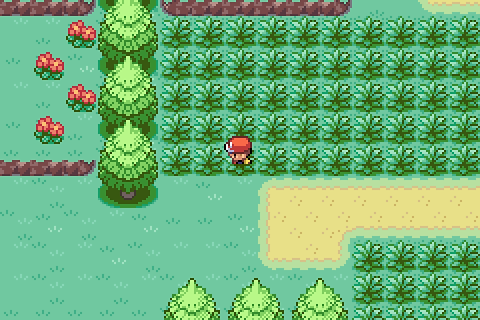


In this lesson, we learned about generators and what they do in a game. To my understanding, it is like a random appearance, when the player touches something, acting as a trigger. For example, in Pokemon games, when the player walks across the grass, a random type of Pokemon appears in the player's way.
PS: Given that it's in Google, this might be updated.
In this lesson, we reviewed our previous game design document to decide whether we stick to the planned Tower of Midas or we should make a new game. We had a constructive discussion and decided to make a new game. We started with a plan by dividing it into stages. For a genre, we chose an action third-person game with a shooting bow. We then assigned each member a certain task to do.
For more details, please see the document above.
How to make Game world Week 5
World Building
In the week 5 lesson, the focus was on researching how a certain world environment could be created by exploring features of a particular period and culture, including how the people behaved and what they looked like, both in terms of ethnicity but also clothing and the type of infrastructure that could be found. By exploring these ideas and doing extensive research on the game's environment, the source material can be respected and be closest to reality.
As an example of this research, we looked at 'Assassin's Creed Origins', exploring the research performed by the development team to replicate an ancient Egyptian environment.
We looked into the research on how the town/city was made for the notorious pyramids of Giza. We then focused on the culture of the people who would be present in this environment, looking at both their clothing and their facial features, This was shown through the implementation of the historical figure Cleopatra, who is shown wearing clothing and jewelry typical of the time period.
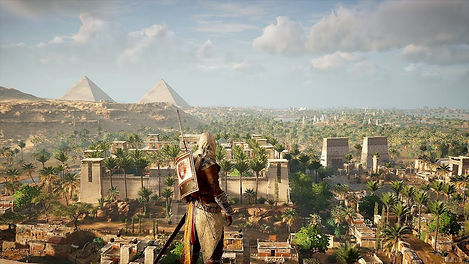
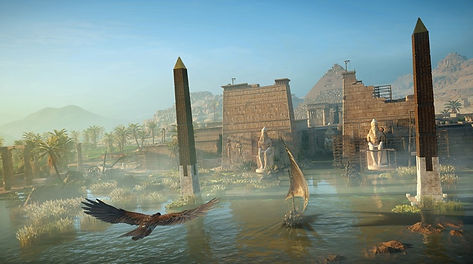


Reflecting on the knowledge I had obtained from the lesson, I tried to create a character based on floating lanterns as featured in many Asian cultures. However, my particular research was towards those found in Japanese cultures. I collected a range of images based on this, utilising the distinctive shapes I found in order to cultivate a series of sketches of a character I could use in a game.
How to make Game world Week 6
motivation and feedback
world
In this lesson, I explored some reference images of different forests; after this, I created some rough concept art of the game's environment that I had envisioned. My aim was for it not to be too perfect or precise; after coming up with these ideas, I wanted for my group to choose one that everyone liked for the game's environment. On the left, you can see my concept work in comparison to the reference images that me and my group gathered in order to design the environment,
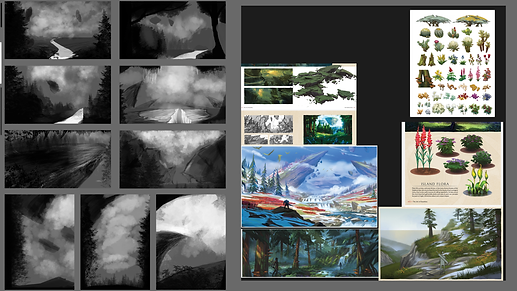
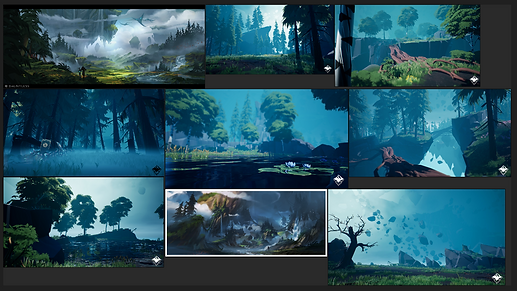

In this class, I made a top view of the environment for the group work, and a map of the environment.
How to make Game world Week 7
Production Schedule with Bradley

In this lesson, I was taught how to make a plan/timeline for the project we are making. It clarifies what steps should be taken to make the working process more efficient and thus easier. It consisted of a table with several bullet points detailing what the focus would be that week.
3D Asset list
1h or 1h/30mi all asset
Burnt Fireplace, natural campfire
.png)

old wooden crates
.png)

wooden barrels
.png)

Japanese wooden lamp
.png)

Buckets
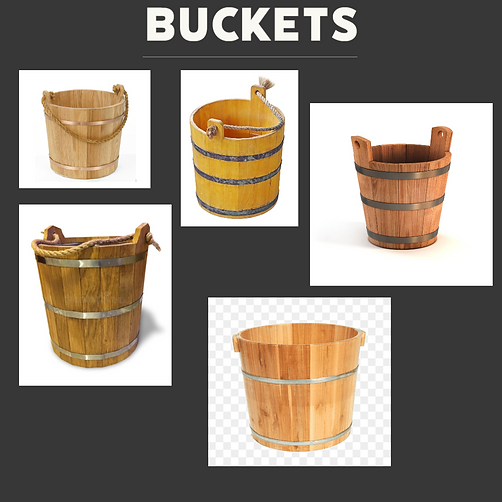

Stylistic well with Japanese wooden well rooftop(water well)
.png)

In this lesson, I created models using Maya of assets which reflect the time period of the world environment in which the story is happening. I started with researching references of the objects I had in mind to then make a model of them.
3D Asset UV list
1h/30mi all UV assets for each

The images above are the models I have made and then UV mapped them before applying the texture. I experienced some difficulties whilst UV mapping as some crashes happened but still managed to do it in the end.
How to make Game world Week 8
Accessibility and inclusive level design
.How to make games more accessible for people with various disabilities. For example, in the 2008 parkour game 'Mirror's Edge, a plethora of subtle details are used to make the game more accessible. In particular, you can see bright colours, such as red (seen in the picture below), that make the path clearer for people who find it difficult to understand complex paths and also colourblind people by adding very contrasting colours to the grey surroundings. It also has clear subtitles at the bottom of the screen for people with hearing disabilities or other difficulties that might make it hard to understand speech, but it also has a voiceover in the background for people if they can't or don't want to read. Providing these options as inbuilt functions makes the game more accessible to many more people despite being small, sometimes unnoticeable changes.
A further example is 'Horzion Zero Dawn', which showcases clear instructions and details of the items as well as having subtitles similar to the previously mentioned Mirror's edge.
As well as the game functions, you also have representation of people with disabilities as characters in the games, which makes real individuals with these feel more included and destigmatises their disabilities. For example, people who are wheelchair-bound or have other motor problems, such as Lester Crest from the GTA series, also have a series of people with lost limbs, deafness, blindness and many more. However, one keynote is that most disabilities shown are clearly visible physical disabilities (and sometimes these aren't shown true to life), which is not an accurate representation of the community and is something that still needs to be worked on in the gaming industry.
Mirror's Edge

Horzion Zero Dawn

3D Asset Texture list
1h/30mi all texture assets for each

Using Adobe substance painter I added texture to the assets I made on Maya before including them in the world environment.
How to make Game world Week 9
Production
Frogwater
Environment Reference Image



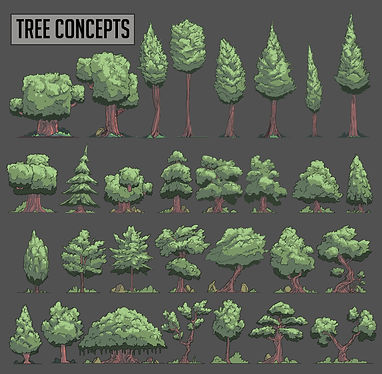
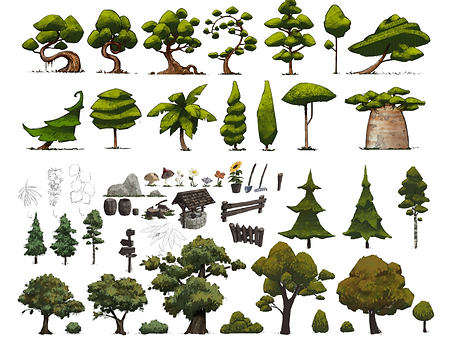

After being given the role was curating concept art and modelling some assets. To begin this process, I researched fantasy games such as 'Genshin Impact' to see how their environments look and base of this research I collected a range of similar reference images of forest environments, particularly choosing those that I felt fit the fantasy genre, and putting these together to create mood boards, as seen above. My group aided this process by providing their opinions and what should be incorporated into the design.
This part of the process was successful, and I was able, for the most part, able to find what I wanted however I found difficulty in finding a variety of tree types that fit my vision, with most of the reference images consisting of the same type of tree and not the variety I had wanted.
Concept Art


Based on my previous research and collection of references I used photoshop to roughly sketch several ideas based on these using shading on a greyscale when drawing to be able to produce the concepts quickly and have a rough idea without being too simple when I group and I choose to expand from the art. I tried to make each as unique as possible, incorporating the parts of the reference images I had most liked like a river, fog and flying islands/rocks to create a dream-like, fantasy environment. My research heavily assisted the creation of my concept art as I had a clear vision in my mind of what I wanted to be included.
The process went well as my research helped me and I also found it as a good experience for producing sketches for the environment also working within the fantasy genre was interesting as I typically work on sci-fi props and characters. What I found difficult with this process was using the shading to create distinct parts as a lot of the time the work blurred together if there wasn't enough contrast which i worked on.
After discussing with my group and showing them my concept art we decided on the best idea to continue with. On photoshop, using my white and black concept art I produced a rough sketch slightly altering it to my group's suggestions, from this I began to add colour, deciding on these based of my previous reference images where I colour-picked a suitable range of colours. After adding the colour i began to refine my art, adding shading, highlights and texture to add more detail. For example in the bushes, using rough and distinct brush strokes I created the appearance of grass stands, additionally, in the trees, I utilised shading and highlights to create individual leaves without it appearing too cartoonish but also not completely realistic, Furthermore, I used models of assets to create drawings in the same style. My research helped with this as it made the colours I used easy to find and also the style of art I wanted, a blend of realism and cartoonish.
This process was good and I enjoyed going back to traditional drawing instead of modelling, however, I found it difficult to transition from my references and concept art into a drawing, as I had to pay more attention to detail.

Using my drawings from before I created a bird's eye view of the environment, creating a map of some sort using a smaller range of colours than in the environment's art. My research didn't assist me in creating this but my work from previously did.
This process allowed me to explore creating a different perspective of the environment that i hadn't practised before, particularly i struggle with how to layout my forest as my group had lots of suggestions that couldn't all be included, also I had to take them into consideration the map in a game sense and if it would be fitting in a game scenario.
AI Art
Using my concept art, my group and I utilised an AI program that generated art. This allowed us to easily visualise the environment we wanted for when we choose to model the game.
This was my first time experimenting with AI and it was fun to see the variations it produced, my group were excited by what it created and that inspired us for the project.
Characters Concept
I collected a range of images of traditional items such as drums, lanterns, golems/statues and clothing/people. Using these a created concept art of characters, once again in black and white these allowed me to create the characters of 'Spirit Drum' based on my research of traditional drums, a sentient 'Floating Lantern', based on my research of lanterns in Asian cultures particularly Japanese, a 'Statue Golumite' based on my research of statues in Asian cultures such as 'the maneki-neko' statue (the waving lucky cat) and stone golems in various media and finally the "Pallid Gentleman", based on my research of traditional Asian clothing and accessories but also tall, slim figures such as slenderman.
My research heavily influenced my work as it gave me a rough idea of what i wanted my work to look like.
I enjoyed researching the specific cultural items and creating a range of ideas based on these, but some aspects were difficult as I wasn't always able to accurately represent the ideas from my reference images and also to provide enough detail for my group member to work off was difficult.
3D Asset Reference Image
I collected a range of images of basic props linked to the environment being created for example barrels, buckets and a campfire.
This process was simple to research as they are simple objects however finding variety was hard.
Concept Art Asset list
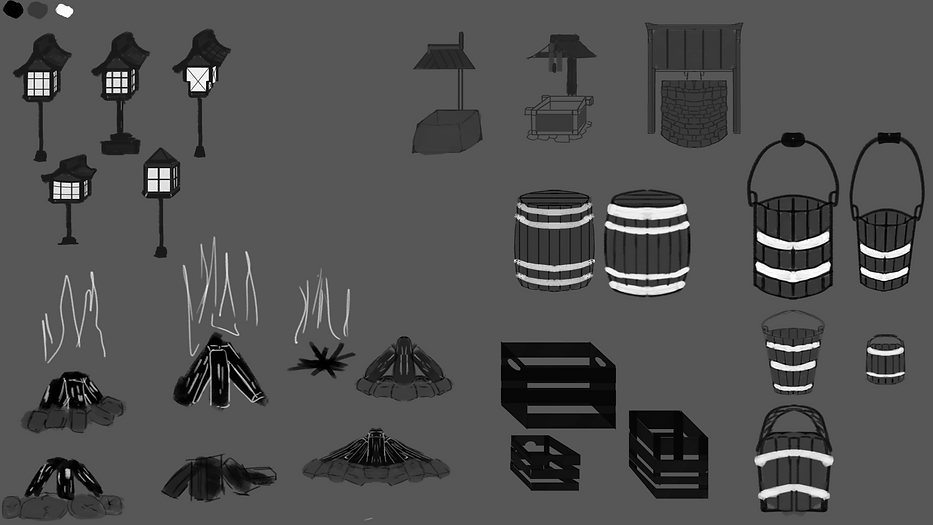
Using my reference images, I tried to create my own ideas based on them, trying to add the unique culture I previously researched for my characters for example with the Japanese lantern my research from creating the floating lantern was useful as many of the shapes are general motifs were similar.
The process was simple due the objects i had choose however it was diffcult to add details and variety in my art with such simple objects particularly with the bucket and barrel as there wasn't much to expand of.
3D Asset list
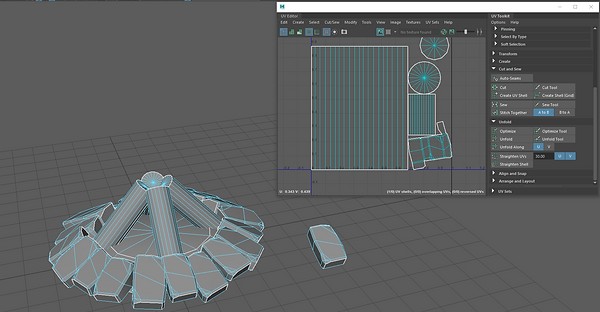
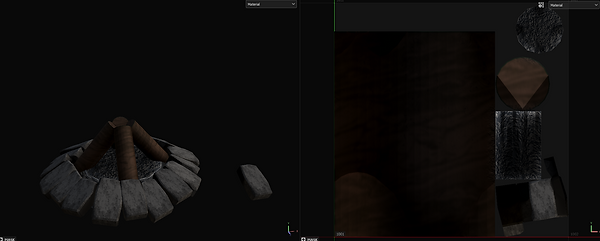
I selected one of my concepts that I thought was best fitting and then using Maya I began to model the campfire. I used a cube and cylinder shape in order to create the stones and logs. When I finished with modelling I used UV mapping to unfold the shape and then used Substance Painter to add colour and texture, using my research from before to select colours and inspire me when creating texture.
This was simple and easy however adding the texture was difficult as I found myself making it too realistic.


I selected one of my concepts that I thought was best fitting and then using Maya I began to model the wooden crates. I used several cube shapes in order to create the wooden planks, slightly distorting them to make them look more unique. When I finished with modelling I used UV mapping to unfold the shape and then used Substance Painter to add colour and texture, using my research from before to select colours and inspire me when creating texture.
This was simple and easy however when nearby objects were close a shadow was created which I had to fix.


I selected one of my concepts that I thought was the best fitting, and then using Maya, I began to model the bucket. I used cube shapes arranging them in a circular shape order to create the wooden planks of the bucket. Additionally, I used a cylinder shape to create the rope by twisting the shape to create the appearance of interweaving threads. Furthermore, I used a cylinder shape to add screws to the bucket. When I finished with modelling, I used UV mapping to unfold the shape and then used Substance Painter to add colour and texture, using my research from before to select colours and inspire me when creating texture.
This is simple and easy however, creating the rope texture both in modelling and Substance Painter was difficult.


I selected one of my concepts that I thought was best fitting and then, using Maya, I began to model the barrel. I used cube shapes, arranging them in a circular arrangement, although slightly bent, curving outwards to create the wooden planks of the barrel but also using cylinders to create the metal outlining. When I finished with modelling, I used UV mapping to unfold the shape and then used Substance Painter to add colour and texture, using my research from before to select colours and inspire me when creating texture.
This was simple however it was difficult to add shadows/blacklines in between the wooden planks to make them look more distinct.


I selected one of my concepts that I thought was the best fitting, and then, using Maya, I began to model the lantern. This one was slightly more complex than the previous ones. I used different-sized cubes, merging them or creating patterns to create the lantern.
I UV mapped this, unfolding the many shapes, I then used Substance Painter to add the wooden texture and the light using the research I had done previously for the colours and textures.
This process was rather simple as I was using simple shapes however I found it difficult when UV mapping because there were many parts, and I had to fit them onto one tile. It was also difficult to add the texture of the light, not having the glow I wanted, furthermore, this could cause further problems when my group used the model therefore, i didn't have a glow.


I selected one of the concept arts that i thought would be most fitting. Using Maya i used cube shapes to create the stones, arranging them in a circular arrangement, furthermore, i used cubes for the roof and pillar, to add an interesting pattern on top. I also used a cylinder shape to make the pulley mechanism within the well. I UV mapped my model and then used a Substance Painter to add texture and colour based on my previous research.
This was once again rather simple, although the most complex model i had made so far, I found adding texture difficult because there were lots of different shapes with their unique shapes, and also the colour and texture were blurry at times. Also arranging the stone shapes in a circular arrangement was difficult and took a lot of time to perfect.
Logo list

.png)


My group and I decided to make a logo, after brainstorming we created a golden frog emblem with a blood splatter behind it. Using an AI art generation program, we inputted our ideas and it generated a range of art for us, we selected the two above and then a group member expanded on this as seen in the bottom left image however we refined this into our final logo on the bottom right.
On the right-hand side, we have our final products.
Experimenting with AI was once again exciting and very inspiring although it was annoying to direct it on producing what we exactly wanted however it allowed for producing a unique and interesting logo.
Environment VIdeo
Analysis of the work:
The Project For Me
As an individual, I was responsible for the concept art/models, and I think I was useful to my team, and took into consideration everyone's contributions and made my work with the necessary detail that made it easy to expand for the other members who were modelling or doing general development of the environment.
I worked out of my comfort zone, exploring techniques and genres I haven't used in a while, for example, doing a fantasy environment; furthermore, researching cultural items for the character and item concepts was interesting, and I enjoyed including aspects of them in my art.
Working As A Group
I think my group's work was rather successful, although slight blunders were made, in particular with planning and organisation, because our timetables didn't always align and sometimes we were getting close to deadlines. Additionally, at times I found it challenging to communicate with my team and didn't fully understand what they meant and wanted from my work; for example, I didn't know what a "Pallid Gentleman" was; however, my group did research and sent me images, and that helped me understand more.
In particular, I think my group's research on specific cultures, environments and characters was specifically successful, and I think this was accurately represented in our work. Also, my group was fun to work with, and it was a bigger group than I usually had worked with, and everyone had an important contribution fitting their skills.
Our work is compared to the industry.
I think our work is not perfect and is more simple than other work in the industry, although i think the work we did as a group is something similar to what you'd find working in the industry. If we were given more time and training, our work would be much better and equal to those in the industry.
Conclusion
Our work has great potential that could be developed further if we were to work it on more. Personally, I think I could have tried communicating with my group more as sometimes I had very interesting ideas that I wouldn't share and wouldn't be used, in my next group project I would change this. I also think my work could have been better if I was provided more time, ideally for the next time I'd want to create more concept art with each having more unique characteristics that I could explore and then expand on. Also, i would try different software as I on multiple occurrences had crashes and errors, which I would be unable to fix.
As a group, we found it difficult to coordinate our time to fit everyone, next time I think it would be important to dedicate more specific times for us to work together and stick to a specific work timetable. Also, everyone had specific roles it was sometimes difficult to merge everyone's work so more communication between individuals would need to be done.












































